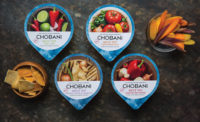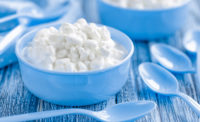Cultures and enzymes are hard workers
Not only do cultures and enzymes impart unique product characteristics, but they also offer solutions for increased shelf stability and production efficiency.










Today’s dairy processors have to cater to a group of consumers who want it all, from reduced-sugar and lactose-free products to long shelf lives and clean labels. So how could they create dairy offerings that meet so many different needs?
Enter cultures and enzymes, dairy production staples that have long been used for fermentation and preservation — and to create a given product’s unique attributes such as mouthfeel and flavor. They also can be key to satisfying new consumer demands.
“Cultures and enzymes are simply indispensable for dairy processors,” says Julien Biolley, director, business development and marketing, food cultures and enzymes for Hoersholm, Denmark-based Chr. Hansen. “Combining them in the right way allows the manufacturer to develop signature products with distinct properties and meet consumer demands for healthy, tasty, authentic, convenient and affordable products.”
Make it last
For the consumers who want to reduce their environmental impact, food waste has come under scrutiny. In response, many dairy processors are looking for solutions to extend the shelf life of their products, says Evandro Oliveira de Souza, business lead, cheese for DSM Food Specialties, Delft, Netherlands.
“Food waste is a prominent issue across the dairy industry, with spoilage from mold and yeast growth being one of the main causes,” he adds. “The pressure on manufacturers to find solutions that help tackle this issue and extend the shelf life of dairy products such as cheese effectively is subsequently rising.”
According to Biolley, the United Nations estimates that one-third of food is wasted, and Chr. Hansen estimates that close to 20% of yogurt goes to waste. This is often due to the expiration date.
“The use of bioprotection can be a key driver in the fight against food waste, which is becoming an increasingly important topic for consumers and regulators worldwide,” he adds.
For dairy processors wanting to keep their labels clean, cultures and enzymes provide ways to extend shelf life without having to add artificial ingredients to an ingredient list. For example, Chr. Hansen offers FreshQ, notes Biolley, a bioprotection solution made from “friendly microorganisms” that can replace chemical additives and that “inhibits spoilage and protects against contamination in food.”
“Our bioprotection technology can help to extend the shelf life of yogurt by up to 10 days — in an all-natural way. It means a lot for consumers to have a couple of extra days to eat a yogurt,” Biolley says.
For its part, DSM offers DelvoCid, a natamycin-based preservative that supports the production of clean-label cheese with a longer shelf life.
“It is colorless, odorless and tasteless and can be applied to protect cheese from spoilage throughout the production process, from brine bath and cheese surface to ripening,” notes Oliveira de Souza.
With longer shelf lives comes another concern: keeping a product’s flavor from changing as it nears its expiration date, says Todd Flynn, application specialist for DuPont Nutrition & Biosciences, New Century, Kan.
“Typically, yogurt increases in acidity throughout shelf life. This means that a yogurt tastes much different after 45 days than it did at seven days,” he explains. “Processors want to mitigate that difference as much as possible so the experience for the consumer is as consistent as possible.”
DuPont recently launched two new cultures, Yo-Mix Prime 800 and 900, that help solve this problem. They control pH and acidity during both the manufacturing process and shelf life, and help to extend expiration dates, says Flynn.
Chr. Hansen offers a similar solution in its Sweety culture — a mild culture that has superior pH stability throughout shelf life.
“This means Sweety yogurts maintain more constant sweetness over shelf life, and added sugar is not needed to mask post acidification,” says Biolley. “Sweety cultures provide solutions that are clean-label and natural.”
More cheese, please
Not only do cultures and enzymes contribute to functional properties of dairy products, but they also can help processors increase yields and efficiencies.
“Dairy processors have been looking for cultures that are innovative and increase performance,” says Kurt van Mol, category director – specialty ingredients for The Ingredient House, Southern Pines, N.C. “For example … cultures that work faster to increase production.”
According to Collette Lentz, group manager, fresh fermented and cheese application for DuPont, enzymes are a great solution for processors that want greater production flexibility so they can produce a broader range of products.
“New enzymes have been developed to work faster, at higher temperatures and with increased purity,” she notes. “This allows for broader processing conditions and higher processing efficiency with one enzyme solution.”
DuPont’s Bonlacta, which is a lactase enzyme that creates reduced-lactose or lactose-free products, offers another benefit: speeding up the production process.
“It allows for manufacturers to make lactose-free products in record time, given the fast-acting nature of the enzyme, and [it] is able to withstand high temperatures to enable new optimized processes with even faster lactose hydrolysis targets — all which allows for process optimization and flexibility not previously seen before,” Lentz says.
Christina S. Barsa, technical sales representative for New York-based Enzyme Development Corp. (EDC), says processors also are looking for ways to speed up the aging process in cheesemaking.
“The addition of a low dosage of Thistle Rennet such as EDC’s Thistlezyme liquid, used in combination with any animal or microbial rennet, helps accelerate the aging and develop the flavors in the cheese,” she adds.
According to Biolley, Chr. Hansen’s recently released coagulant Chy-Max Supreme not only helps makes cheese faster, but also produces up to 1% more cheese with the same amount of milk. This increased yield is a boon for processors, and it makes cheese production more sustainable.
“One percent more may not sound like much, but just to put that into perspective: A 1% yield increase of global cheese production means close to 500 million pounds more cheese without the use of more milk,” he says. “That is enough to satisfy the yearly cheese consumption of 15 million American consumers.”
Marshfield, Wis.-based Nelson-Jameson Inc. also offers yield-increasing cultures, say Dan Williams, technical sales manager, and Steve Funk, national accounts manager, through a partnership with DSM. For example, DSM’s new mozzarella culture Delvo Cheese CP-500 increases yield up to 1.3%.
“This product also improves the eating experience of pizza due to outstanding stretch and melt behavior, less browning and better (buttery) taste,” they note.
Delvo Cheese CP-500 can be combined with DSM’s Maxiren XDS coagulants for an even larger yield increase, explains Oliveira de Souza. The coagulants also improve the firmness of cheese, making for easier slicing and shredding.
“This reduces cutting losses by up to 15%, reducing waste and lowering the carbon footprint of an operation by as much as 12%,” he adds.
Keep it healthy
Dairy processors also turn to cultures and enzymes to help them meet the nutritional needs of their consumers. Many companies look for options that offer more than one health benefit, says Lentz, and DuPont’s Nurica enzyme does just that.
“Nurica is the all-in-one enzyme solution that answers three of the nutrition trends, with lower sugar, increased prebiotic dietary fiber and reduced lactose,” she says.
Sugar reduction is a very common request from processors, says Biolley.
“Health organizations, governments and retailers are setting objectives to reduce sugar in foods,” he notes. “Consumers are also increasingly focused on sugar content and looking for healthy, natural products that still taste great.”
Yogurt products, in particular, are scrutinized for their added sugar content. And processors could use Chr. Hansen’s Sweety culture to help with that, says Biolley.
“Unlike common yogurt cultures, the patented Sweety culture utilizes more of the natural lactose in milk and leaves glucose in the product matrix,” he says. “Glucose provides more sweetness than the otherwise residual lactose, meaning that less sugar needs to be added for the same sweetness intensity of the final fermented milk product.”
There also is high demand for lactase enzymes as processors create more reduced-lactose and lactose-free products, says Barsa. For its part, EDC offers Enzeco Lactase KL, a lactase enzyme that is added post-pasteurization, which means the lactase is hydrolyzed while the packaged milk sits in the warehouse.
“Dairy processors are looking to optimize their production by having the lactose conversion happen in the finished packaging,” she adds.
Dairy alternatives
Cultures and enzymes also are used to create plant-based alternatives. While many vegan bases have been popular over the years, Barsa says “oatmilk” is currently the trendiest.
Several enzymes aid in the production of oat-based dairy alternatives, including amylases, which reduce viscosity and improve mouthfeel, and glucoamylase, which adds sweetness, she explains.
DuPont has a variety of cultures in its Danisco Vege line, says Flynn, which can be used with an assortment of vegan bases.
“They each have their own attributes that allow them to ferment in numerous plant-based substrates, e.g., coconut, almond, oat, soy, cashew, etc.,” he explains.
Chr. Hansen also offers cultures designed for plant-based products, says Biolley. For example, its probiotics Bifidobacterium BB-12 and Nu-Trish LGG can ferment any vegan base while adding the benefits of probiotics.
“Fermented plant-based alternatives are an exciting, growing food category,” he says. “We have a series of cultures for fermented plant bases, which enables our customers to make healthy plant-based products with the qualities we traditionally ascribe to dairy yogurt: a mild and fresh taste, smooth texture and safe and healthy products.”
And Chr. Hansen will be further investing in developing plant-based fermented foods, Biolley explains. The company recently joined MISTA, a California-based incubator with members that include Danone and Mars. The incubator focuses on developing “sustainable, innovative foods and related technologies.”
“MISTA brings together the power and expertise of large companies operating in different segments of the value chain and the agility and fast-paced innovation spirit of startups in accelerating research — and ultimately new product development — within the exciting space of fermented plant-based,” he adds.
Looking for a reprint of this article?
From high-res PDFs to custom plaques, order your copy today!











